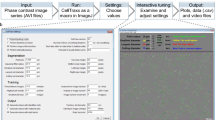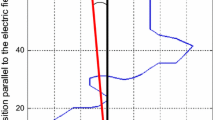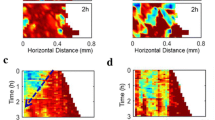Abstract
Collective cell migration plays an important role in wound healing, organogenesis, and the progression of metastatic disease. Analysis of collective migration typically involves laborious and time-consuming manual tracking of individual cells within cell clusters over several dozen or hundreds of frames. Herein, we develop a label-free, automated algorithm to identify and track individual epithelial cells within a free-moving cluster. We use this algorithm to analyze the effects of partial E-cadherin knockdown on collective migration of MCF-10A breast epithelial cells directed by an electric field. Our data show that E-cadherin knockdown in free-moving cell clusters diminishes electrotactic potential, with empty vector MCF-10A cells showing 16% higher directedness than cells with E-cadherin knockdown. Decreased electrotaxis is also observed in isolated cells at intermediate electric fields, suggesting an adhesion-independent role of E-cadherin in regulating electrotaxis. In additional support of an adhesion-independent role of E-cadherin, isolated cells with reduced E-cadherin expression reoriented within an applied electric field 60% more quickly than control. These results have implications for the role of E-cadherin expression in electrotaxis and demonstrate proof-of-concept of an automated algorithm that is broadly applicable to the analysis of collective migration in a wide range of physiological and pathophysiological contexts.





Similar content being viewed by others
References
Aftab, O., M. Fryknäs, U. Hammerling, R. Larsson, and M. G. Gustafsson. Detection of cell aggregation and altered cell viability by automated label-free video microscopy: A promising alternative to endpoint viability assays in high- throughput screening. J. Biomol. Screen. 20:372–381, 2015.
Ahrens, E. T., and J. Zhong. In vivo MRI cell tracking using perfluorocarbon probes and fluorine-19 detection. NMR Biomed. 26:860–871, 2013.
Anon, E., X. Serra-Picamal, P. Hersen, N. C. Gauthier, M. P. Sheetz, X. Trepat, and B. Ladoux. Cell crawling mediates collective cell migration to close undamaged epithelial gaps. Proc. Natl. Acad. Sci. 109:10891–10896, 2012.
Arora, A., and T. Qazi. Computer vision based tracking of biological cells: A review. Int. Conf. Adv. Res. Innov. 118–126, 2014.
Bengtsson, E., C. Wahlby, and J. Lindblad. Robust Cell Image segmentation methods. Pattern Recognit. Image Anal. 14:157–167, 2004.
Bradley, M. O., and N. A. Sharkey. Metagenicity and toxicity of visivle fluorescent light to cultured mammalian cells. Nature 267:673–678, 1977.
Cai, D., S. C. Chen, M. Prasad, L. He, X. Wang, V. Choesmel-Cadamuro, J. K. Sawyer, G. Danuser, and D. J. Montell. Mechanical feedback through E-cadherin promotes direction sensing during collective cell migration. Cell 157:1146–1159, 2014.
Carey, S. P., A. Starchenko, A. L. McGregor, and C. A. Reinhart-King. Leading malignant cells initiate collective epithelial cell invasion in a three-dimensional heterotypic tumor spheroid model. Clin. Exp. Metastasis 30:615–630, 2013.
Chalfound, J., M. Kociolek, A. Dima, M. Halter, A. Cardone, A. Peskin, P. Bajcsy, and M. Brady. Segmenting time-lapse phase contrast images of adjacent NIH 3T3 cells. J. Microsc. 249:41–52, 2013.
Clark, A. G., and D. M. Vignjevic. Modes of cancer cell invasion and the role of the microenvironment. Curr. Opin. Cell Biol. 36:13–22, 2015.
Cuzick, J., R. Holland, V. Barth, R. Davies, M. Faupel, I. Fentiman, H. J. Frischbier, J. L. LaMarque, M. Merson, V. Sacchini, D. Vanel, and U. Veronesi. Electropotential measurements as a new diagnostic modality for breast cancer. Lancet 352:359–363, 1998.
Débarre, D., and E. Beaurepaire. Quantitative characterization of biological liquids for third-harmonic generation microscopy. Biophys. J. 92:603–612, 2007.
Fogg, V. C., C.-J. Liu, and B. Margolis. Multiple regions of Crumbs3 are required for tight junction formation in MCF10A cells. J. Cell Sci. 118:2859–2869, 2005.
Friedl, P., and D. Gilmour. Collective cell migration in morphogenesis, regeneration and cancer. Nat. Rev. Mol. Cell Biol. 10:445–457, 2009.
Friedl, P., J. Locker, E. Sahai, and J. E. Segall. Classifying collective cancer cell invasion. Nat. Cell Biol. 14:777–783, 2012.
Graham, N. A., and A. R. Asthagiri. Epidermal growth factor-mediated T-cell factor/lymphoid enhancer factor transcriptional activity is essential but not sufficient for cell cycle progression in nontransformed mammary epithelial cells. J. Biol. Chem. 279:23517–23524, 2004.
Hazan, R. B., and L. Norton. The epidermal growth factor receptor modulates the interaction of E-cadherin with the actin cytoskeleton. J Biol Chem 273:9078–9084, 1998.
Jaccard, N., N. Szita, and L. D. Griffin. Computer methods in biomechanics and biomedical engineering: Imaging and visualization segmentation of phase contrast microscopy images based on multi-scale local Basic Image Features histograms. Comput. Methods Biomech. Biomed. Eng. Imaging Vis. 1–9, 2015.
Kushiro, K., and A. R. Asthagiri. Modular design of micropattern geometry achieves combinatorial enhancements in cell motility. Langmuir 28:4357–4362, 2012.
Lalli, M. L., and A. R. Asthagiri. Collective migration exhibits greater sensitivity but slower dynamics of alignment to applied electric fields. Cell. Mol. Bioeng. 8:247–257, 2015.
Latt, S. A. Optical studies of metaphase chromosome organization. Clin. Genet. 19:154–161, 1976.
Li, L., R. Hartley, B. Reiss, Y. Sun, J. Pu, D. Wu, F. Lin, T. Hoang, S. Yamada, J. Jiang, and M. Zhao. E-cadherin plays an essential role in collective directional migration of large epithelial sheets. Cell. Mol. Life Sci. 69:2779–2789, 2012.
Li, X., and J. Kolega. Effects of direct current electric fields on cell migration and actin filament distribution in bovine vasclar endothelial cells. J. Vasc. Res. 39:391–404, 2002.
Marrison, J., L. Räty, P. Marriott, and P. O’Toole. Ptychography–a label free, high-contrast imaging technique for live cells using quantitative phase information. Sci. Rep. 3:2369, 2013.
McCaig, C. D., B. Song, and A. M. Rajnicek. Electrical dimensions in cell science. J. Cell Sci. 122:4267–4276, 2009.
Meijering, E. Cell segmentation: 50 years down the road. IEEE Signal Process. Mag. 29:140–145, 2012.
Milano, D. F., N. A. Ngai, S. K. Muthuswamy, and A. R. Asthagiri. Regulators of metastasis modulate the migratory response to cell contact under spatial confinement. Biophys. J. 110:1886–1895, 2016.
Mousavi, S. J., M. H. Doweidar, and M. Doblaré. 3D computational modelling of cell migration: A mechano-chemo-thermo-electrotaxis approach. J. Theor. Biol. Elsevier 329:64–73, 2013.
Ng, M. R., A. Besser, G. Danuser, and J. S. Brugge. Substrate stiffness regulates cadherin-dependent collective migration through myosin-II contractility. J. Cell Biol. 199:545–563, 2012.
Oka, H., H. Shiozaki, K. Kobayashi, M. Inoue, H. Tahara, T. Kobayashi, Y. Takatsuka, N. Matsuyoshi, S. Hirano, M. Takeichi, and T. Mori. Expression of E-cadherin cell adhesion molecules in human breast cancer tissues and its relationship to metastasis. Cancer Res. 53:1696–1701, 1993.
Olivier, N., M. A. Luengo-oroz, L. Duloquin, E. Faure, T. Savy, I. Veilleux, X. Solinas, D. Débarre, P. Bourgine, A. Santos, N. Peyriéras, and E. Beaurepaire. Cell Lineage Reconstr. Early. 70, 2007.
Onder, T. T., P. B. Gupta, S. A. Mani, J. Yang, E. S. Lander, and R. A. Weinberg. Loss of E-cadherin promotes metastasis via multiple downstream transcriptional pathways. Cancer Res. 68:3645–3654, 2008.
Progatzky, F., M. J. Dallman, and C. Lo Celso. From seeing to believing: labelling strategies for in vivo cell-tracking experiments. Interface Focus 3:1–14, 2013.
Pu, J., C. D. McCaig, L. Cao, Z. Zhao, J. E. Segall, and M. Zhao. EGF receptor signalling is essential for electric-field-directed migration of breast cancer cells. J. Cell Sci. 120:3395–3403, 2007.
Rodriguez, L. L., and I. C. Schneider. Directed cell migration in multi-cue environments. Integr. Biol. 5:1306–1323, 2013.
Rompolas, P., E. R. Deschene, G. Zito, D. G. Gonzalez, I. Saotome, A. M. Haberman, and V. Greco. Live imaging of stem cell and progeny behaviour in physiological hair-follicle regeneration. Nature 487:496–499, 2012.
Sandquist, J. C., K. I. Swenson, K. A. Demali, K. Burridge, and A. R. Means. Rho kinase differentially regulates phosphorylation of nonmuscle myosin II isoforms A and B during cell rounding. J. Biol. Chem. 281:35873–35883, 2006.
Sbalzarini, I., and P. Koumoutsakos. Feature point tracking and trajectory analysis for video imaging in cell biology. J. Struct. Biol. 151:182–195, 2005.
Schindelin, J., I. Arganda-Carreras, E. Frise, V. Kaynig, M. Longair, T. Pietzsch, S. Preibisch, C. Rueden, S. Saalfeld, B. Schmid, J.-Y. Tinevez, D. J. White, V. Hartenstein, K. Liceiri, P. Tomancak, and A. Cardona. Fiji: an open source platform for biological image analysis. Nat. Methods 9:676–682, 2012.
Schmalhofer, O., S. Brabletz, and T. Brabletz. E-cadherin, β-catenin, and ZEB1 in malignant progression of cancer. Cancer Metastasis Rev. 28:151–166, 2009.
Sommers, C., E. Gelmann, C. L. Sommers, E. W. Thompson, R. Kemlen, E. P. Gelmann, S. W. Byers, and A. Torn. Cell adhesion molecule uvomorulin expression in human breast cancer cell lines: Relationship to morphology and invasive capacities Uvomorulin Breast Cancer Cell Lines: Relationship and Invasive in Human to Morphology. Cell Growth Differ. 2:365–372, 1991.
Song, B., Y. Gu, J. Pu, B. Reid, Z. Zhao, and M. Zhao. Application of direct current electric fields to cells and tissues in vitro and modulation of wound electric field in vivo. Nat. Protoc. 2:1479–1489, 2007.
Tsai, H. F., C. W. Huang, H. F. Chang, J. J. W. Chen, C. H. Lee, and J. Y. Cheng. Evaluation of EGFR and RTK signaling in the electrotaxis of lung adenocarcinoma cells under direct-current electric field stimulation. PLoS ONE 8:1–20, 2013.
Van Roy, F., and G. Berx. The cell-cell adhesion molecule E-cadherin. Cell. Mol. Life Sci. 65:3756–3788, 2008.
Veit, W., C. Held, R. Palmisano, and T. Wittenberg. Segmentation of HeLa cells in phase-contrast images with and without DAPI stained cell nuclei. Biomed. Technol. 57:519–522, 2012.
Wang, Y., Z. Zhang, H. Wang, and S. Bi. Segmentation of the clustered cells with optimized boundary detection in negative phase contrast images. PLoS ONE 10:e0130178, 2015.
Witta, S. E., R. M. Gemmill, F. R. Hirsch, C. D. Coldren, K. Hedman, L. Ravdel, B. Helfrich, R. Dziadziuszko, D. C. Chan, M. Sugita, Z. Chan, A. Baron, W. Franklin, H. A. Drabkin, L. Girard, A. F. Gazdar, J. D. Minna, and P. A. Bunn. Restoring E-cadherin expression increases sensitivity to epidermal growth factor receptor inhibitors in lung cancer cell lines. Cancer Res. 66:944–950, 2006.
Wu, D., X. Ma, and F. Lin. DC electric fields direct breast cancer cell migration, induce EGFR polarization, and increase the intracellular level of calcium ions. Cell Biochem. Biophys. 67:1115–1125, 2013.
Yu, Y., C. Feng, Y. Hong, J. Liu, S. Chen, K. M. Ng, K. Q. Luo, and B. Z. Tang. Cytophilic fluorescent bioprobes for long-term cell tracking. Adv. Mater. 23:3298–3302, 2011.
Zhao, M. Electrical fields in wound healing-An overriding signal that directs cell migration. Semin. Cell Dev. Biol. 20:674–682, 2009.
Acknowledgments
We thank the members of the Asthagiri group for helpful discussions. This work was supported by the National Institutes of Health Grant R01CA138899.
Conflict of Interest
Mark L. Lalli, Brooke Wojeski, and Anand R. Asthagiri declare that they have no conflict of interest.
Ethical Standards
No human or animal studies were carried out by the authors for this article.
Author information
Authors and Affiliations
Corresponding author
Additional information
Associate Editor Michael R. King oversaw the review of this article.
Electronic supplementary material
Below is the link to the electronic supplementary material.
Rights and permissions
About this article
Cite this article
Lalli, M.L., Wojeski, B. & Asthagiri, A.R. Label-Free Automated Cell Tracking: Analysis of the Role of E-cadherin Expression in Collective Electrotaxis. Cel. Mol. Bioeng. 10, 89–101 (2017). https://doi.org/10.1007/s12195-016-0471-6
Received:
Accepted:
Published:
Issue Date:
DOI: https://doi.org/10.1007/s12195-016-0471-6




